Understanding vowel sounds Normal Alphabet Worksheets for 8-Year-Olds
3 filtered results
-
From - To
Enhance your child's reading skills with our specially designed "Understanding Vowel Sounds Normal Alphabet Worksheets for 8-Year-Olds." These engaging, educational worksheets focus on distinguishing short and long vowel sounds, reinforcing crucial phonetic skills for young learners. With captivating exercises and fun activities, children can practice recognizing and articulating vowel sounds in various words, boosting their literacy foundation. Ideal for classroom and home use, these worksheets support comprehensive skill development, enabling children to read with confidence and fluency. Give your child the essential tools for reading success by incorporating our vowel sounds exercises into their routine.


Reading: OW and OU Words Worksheet


Reading: Long a and Short a Worksheet


Long and Short I Worksheet
Understanding vowel sounds within the normal alphabet is crucial for 8-year-olds because it builds the foundation for proficient reading and writing. At this age, kids are transitioning from simple word recognition to more complex language skills, and vowels play a central role in this process.
Vowels are integral to word formation and pronunciation. Mastery of vowel sounds helps children decode words accurately and fluently, which enhances their reading comprehension. For instance, understanding that the vowel 'a' can sound different in words like "cat," "cake," and "car" allows children to approach new words with confidence.
Additionally, spelling heavily relies on vowel sounds. Knowledge of these sounds aids children in spelling words correctly, which is essential for effective written communication. For example, recognizing that the long 'e' sound can be represented by 'ea' as in "eat," 'ee' as in "feet," or even 'y' as in "silly" helps children internalize spelling patterns.
Supporting 8-year-olds in mastering vowel sounds also encourages a lifelong love of reading. As children become more skillful readers, they are more likely to enjoy books and other reading materials, fostering a positive attitude toward learning. Therefore, parents and teachers should prioritize this understanding as it directly impacts a child’s literacy development and overall educational success.

 Assign to My Students
Assign to My Students



















